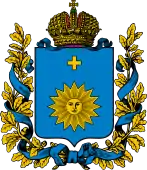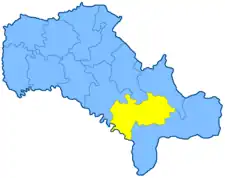Olgopol uezd
The Olgopol uezd[lower-alpha 1] was a county (uezd) of the Podolia Governorate of the Russian Empire, with its administrative centre in Olgopol (modern-day Olhopil). It bordered the Bratslav and Gaysin uezds to the north, the Balta uezd, the Orgeev uezd of the Bessarabia Governorate to the south, the Yampol uezd to the west.
Olgopol uezd
Ольгопольскій уѣздъ | |
|---|---|
 Coat of arms | |
 Location in the Podolia Governorate | |
| Country | Russian Empire |
| Krai | Southwestern |
| Governorate | Podolia |
| Established | 1795 |
| Abolished | 1923 |
| Capital | Olgopol |
| Area | |
| • Total | 4,008.14 km2 (1,547.55 sq mi) |
| Population (1897) | |
| • Total | 284,253 |
| • Density | 71/km2 (180/sq mi) |
| • Urban | 2.86% |
| • Rural | 97.14% |
Administrative divisions
The subcounties (volosts) of the Olgopol uezd in 1912 were as follows:[1]
| Name | Name in Russian | Capital |
|---|---|---|
| Bershad volost | Бершадская волость | Bershad |
| Voitovka volost | Войтовская волость | Voitovka |
| Demovka volost | Демовская волость | Demovka |
| Zhabokrych volost | Жабокрычская волость | Zhabokrych |
| Kamenka volost | Каменская волость | Kamenka |
| Lugi volost | Лугская волость | Lugi |
| Myastkovka volost | Мястковская волость | Myastkovka |
| Obodovka volost | Ободовская волость | Obodovka |
| Peschanka volost | Песчанская волость | Peschanka |
| Pyatkovka volost | Пятковская волость | Pyatkovka |
| Rashkov volost | Рашковская волость | Rashkov |
| Uste volost | Устьянская волость | Uste |
| Chebotarka volost | Чеботарская волость | Chebotarka |
| Chechelnik volost | Чечельницкая волость | Chechelnik |
Demographics
At the time of the Russian Empire Census on 28 January [O.S. 15 January] 1897, the Olgopol uezd had a population of 284,253, including 140,810 men and 143,443 women. The majority of the population indicated Little Russian[lower-alpha 2] to be their mother tongue, with a significant Jewish speaking minority.[4]
| Language | Native speakers | Percentage |
|---|---|---|
| Little Russian[lower-alpha 2] | 231,991 | 81.61 |
| Jewish | 32,555 | 11.45 |
| Romanian | 8,135 | 2.86 |
| Great Russian[lower-alpha 2] | 6,321 | 2.22 |
| Polish | 4,325 | 1.52 |
| German | 592 | 0.21 |
| Tatar | 92 | 0.03 |
| Czech | 72 | 0.03 |
| White Russian[lower-alpha 2] | 52 | 0.02 |
| Romani | 39 | 0.01 |
| French | 21 | 0.01 |
| Chuvash | 17 | 0.01 |
| Latvian | 11 | 0.00 |
| Bashkir | 4 | 0.00 |
| Mordovian | 3 | 0.00 |
| Other | 23 | 0.01 |
| Total | 284,253 | 100.00 |
Notes
- Prior to 1918, the Imperial Russian government classified Russians as the Great Russians, Ukrainians as the Little Russians, and Belarusians as the White Russians. After the creation of the Ukrainian People's Republic in 1918, the Little Russians identified themselves as "Ukrainian".[2] Also, the Belarusian Democratic Republic which the White Russians identified themselves as "Belarusian".[3]
References
- Волостныя, станичныя, сельския, гминныя правления и управления, а также полицейские станы всей России с обозначением места их нахождения [Volostny, stanichnaya, rural, communes of government and administration, as well as police camps throughout Russia with the designation of their location]. Kiev: Izd-vo T-va L. M. Fish. 1913. p. 162. Archived from the original on 2022-12-11.
- Hamm, Michael F. (2014). Kiev: A Portrait, 1800–1917. Princeton University Press. p. 83. ISBN 978-1-4008-5151-5.
- Fortson IV, Benjamin W. (2011). Indo-European Language and Culture: An Introduction. John Wiley & Sons. p. 429. ISBN 978-1-4443-5968-8.
- "Демоскоп Weekly - Приложение. Справочник статистических показателей". www.demoscope.ru. Retrieved 2019-12-19.
This article is issued from Wikipedia. The text is licensed under Creative Commons - Attribution - Sharealike. Additional terms may apply for the media files.